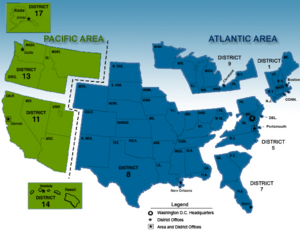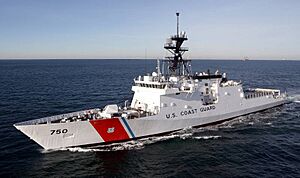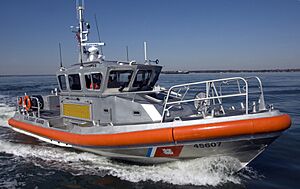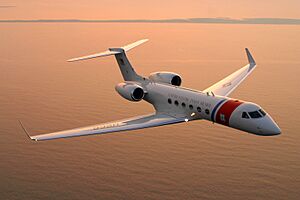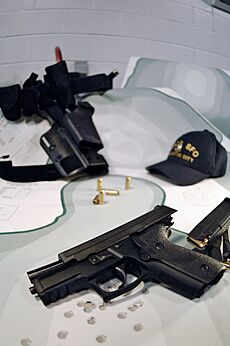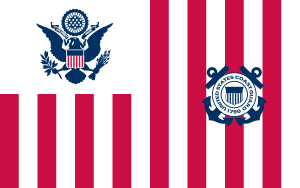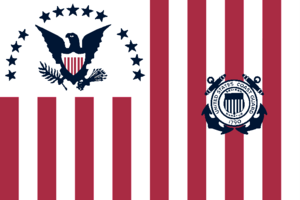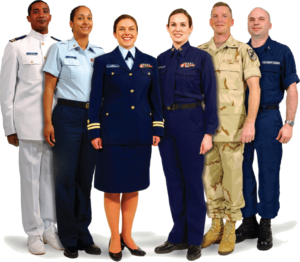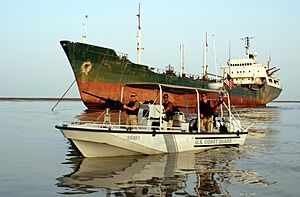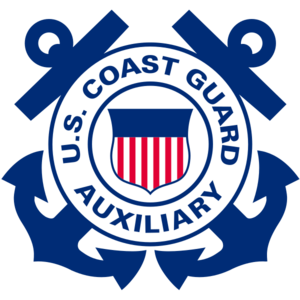United States Coast Guard facts for kids
Quick facts for kids United States Coast Guard |
|
|---|---|
 Seal of the United States Coast Guard  U.S. Coast Guard service mark |
|
| Founded | 28 January 1915 (110 years, 10 months) (As current service) 4 August 1790 |
| Country | |
| Type | Coast guard |
| Role | Port and waterway security Aids to navigation Search and rescue Illegal, unreported and unregulated fishing Marine safety Defense readiness Migrant interdiction Marine environmental protection Ice operations Law enforcement |
| Size | 40,558 active duty personnel 7,724 reserve personnel 21,000 auxiliarists 8,577 civilian personnel (as of 2020) |
| Part of | United States Armed Forces Department of Homeland Security |
| Headquarters | Douglas A. Munro Coast Guard Headquarters Building, Washington, D.C., U.S. |
| Nickname(s) |
|
| Motto(s) |
|
| Colors | CG Red, CG Blue, White |
| March | "Semper Paratus" |
| Anniversaries | 4 August |
| Equipment | List of U.S. Coast Guard equipment |
| Engagements |
See list
Quasi-War
War of 1812 Seminole Wars West Indies Anti-Piracy Operations African Anti-Slavery Operations Mexican–American War American Civil War Spanish–American War World War I World War II Korean War Vietnam War Invasion of Grenada Invasion of Panama Persian Gulf War Operation Uphold Democracy Kosovo War War in Afghanistan Iraq War Operation Inherent Resolve |
| Commanders | |
| Commander-in-Chief | |
| Secretary of Homeland Security | |
| Commandant | |
| Vice Commandant | |
| Master Chief Petty Officer of the Coast Guard | MCPOCG Heath B. Jones |
| Insignia | |
| Ensign |  |
| Service Mark |  |
| Flag |  |
| Jack | 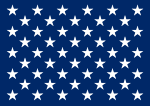 |
| Wordmark | |
The United States Coast Guard (USCG) is a special part of the U.S. Armed Forces. It handles security at sea, helps people in danger, and enforces laws on the water. It's one of eight uniformed services in the country.
The Coast Guard is unique because it's a military branch that also acts as a law enforcement agency. It has power in both U.S. and international waters. It's the largest coast guard in the world, almost as big and capable as many navies.
This service helps people and keeps the country safe. It protects U.S. borders and important economic interests around the world. It also defends the country by keeping shipping lanes safe in U.S. waters and its Exclusive Economic Zone. Because of threats at sea and online, the Coast Guard works on all seven continents and in cyberspace. Like the United States Navy, the Coast Guard has people stationed all over the world. Its ships are used for diplomacy, helping others, and security. As a humanitarian service, it saves thousands of lives each year. It also helps with disaster response after natural or human-made events.
The U.S. Coast Guard usually works under the U.S. Department of Homeland Security during peaceful times. If there's a war, the U.S. President or Congress can move it to the U.S. Department of the Navy. This has only happened twice: during World War I in 1917 and World War II in 1941. Before 2003, it was part of the United States Department of Transportation. Even earlier, it was under the United States Department of the Treasury until 1967.
The Coast Guard started on August 4, 1790, as the Revenue-Marine. Alexander Hamilton asked Congress to create it. Its first job was to collect taxes on goods coming into U.S. seaports. This makes it the oldest continuously operating naval service in the United States. The name changed to the U.S. Revenue Cutter Service by the 1860s.
The modern U.S. Coast Guard was formed on January 28, 1915. This happened when the U.S. Revenue Cutter Service joined with the U.S. Life-Saving Service. In 1939, the U.S. Lighthouse Service also became part of the Coast Guard. As one of the country's six armed services, the Coast Guard has supported every major U.S. war since 1790. This includes conflicts from the Quasi-War with France to the Global War on Terrorism.
As of December 2021, the Coast Guard has about 44,500 active duty members and 7,000 reservists. It also includes 8,577 civilian employees and 31,000 volunteers in the U.S. Coast Guard Auxiliary. The service has about 250 large ships called cutters, patrol ships, and icebreakers. It also has nearly 2,000 smaller boats and specialized craft. Its aviation division has over 200 helicopters and airplanes. Even though it's the second smallest U.S. military branch, the Coast Guard alone is the world's 12th largest naval force.
Contents
- What the Coast Guard Does: Its Missions
- The Coast Guard's Story: Its History
- How the Coast Guard is Organized
- Who Works for the Coast Guard: Personnel
- Coast Guard Equipment
- Symbols and Values of the Coast Guard
- Uniforms of the Coast Guard
- Coast Guard Reserve: Ready to Serve
- Women in the Coast Guard
- Coast Guard Auxiliary: Volunteers Helping Out
- Awards and Honors for Coast Guard Members
- Famous People in the Coast Guard
- Coast Guard Organizations
- Images for kids
- See also
What the Coast Guard Does: Its Missions
The Coast Guard's Main Roles
The Coast Guard has three main jobs, which are broken down into eleven specific missions. These three roles are:
- Keeping people safe at sea (Maritime safety).
- Protecting the country from threats at sea (Maritime security).
- Taking care of the ocean's resources (Maritime stewardship).
The Coast Guard is known for being quick and flexible in emergencies. This is because it's organized in a way that allows even junior members to take on a lot of responsibility. After Hurricane Katrina in 2005, Time magazine praised the Coast Guard. They said its flexibility and spirit were a great example for military efforts during disasters. A rescue swimmer named Wil Milam said, "In the Navy, it was all about the mission. In the Coast Guard, it was, take care of our people and the mission will take care of itself."
Specific Missions of the Coast Guard
The eleven missions are divided into two groups: those for homeland security and those that are not.
Missions for General Safety and Support
- Ice operations, including the International Ice Patrol.
- Protecting ocean life and enforcing fishing laws.
- Keeping the marine environment clean.
- Ensuring safety at sea.
- Maintaining aids to navigation (like buoys and lighthouses).
- Search and rescue operations.
Homeland Security Missions
- Being ready for defense.
- Enforcing laws at sea.
- Stopping people from entering the country illegally by sea.
- Protecting ports, waterways, and coastal areas.
- Stopping illegal activities.
Search and Rescue Operations
The U.S. Coast Guard's Search and Rescue (CG-SAR) is one of its most famous jobs. The National Search and Rescue Plan says the Coast Guard is in charge of SAR operations at sea. The United States Air Force handles SAR on land. Both services have rescue coordination centers to plan these efforts. They help both military and civilian search and rescue. They also provide instructors for the National Search and Rescue School. This school trains people to plan and coordinate SAR missions. It's located at Coast Guard Training Center Yorktown in Virginia.
National Maritime Center: Mariner Credentials
The National Maritime Center (NMC) is part of the Coast Guard. It's responsible for giving out official papers (credentials) to merchant mariners. Its job is to make sure that only qualified mariners work in U.S. waters. This helps keep the marine transportation system safe and clean.
Why the Coast Guard is a Military Service
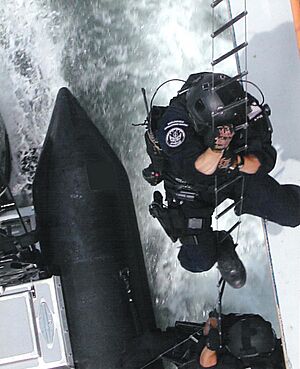
The Coast Guard is one of the six U.S. Armed Forces branches. Title 10 of the U.S. Code lists it alongside the Army, Marine Corps, Navy, Air Force, and Space Force. Title 14 of the United States Code states that the Coast Guard is always a military service. It works under the Department of Homeland Security. However, it can work for the Navy during wartime.
On November 25, 2002, President George W. Bush signed the Homeland Security Act. This law moved the Coast Guard under the U.S. Department of Homeland Security. This change happened on March 1, 2003.
Coast Guardsmen are military members. They follow the Uniform Code of Military Justice. They also get the same pay as members of other military services.
The Coast Guard has been in every major U.S. conflict since 1790. This includes landing troops on D-Day in World War II. They also did patrols and bombardments during the Vietnam War. In recent conflicts like the Iraq War, they focused on stopping ships, coastal security, and law enforcement.
In 2007, the Coast Guard, U.S. Navy, and U.S. Marine Corps created a new plan. It's called A Cooperative Strategy for 21st Century Seapower. This plan aims to prevent wars as much as fighting them. It helps these services work together with international partners. They try to prevent crises or react quickly to avoid problems for the United States.
Why the Coast Guard is a Law Enforcement Agency
Title 14 USC, section 2 allows the Coast Guard to enforce U.S. federal laws. This means all Coast Guard officers and petty officers have law enforcement powers. Unlike other military branches, the Coast Guard is allowed to act as a law enforcement agency. This is because it is exempt from the Posse Comitatus Act.
Coast Guardsmen can carry their service-issued firearms both on and off base. However, commanders often prefer that weapons are kept in armories when not in use.
The Coast Guard's Story: Its History
The Coast Guard started in the 1790s. It was a small group of ships managed by the United States Department of the Treasury. Their job was to collect taxes on imports. Secretary of the Treasury Alexander Hamilton asked Congress to fund ten ships. This happened on August 4, 1790, which is now the Coast Guard's official birthday. Before the Navy was re-established in 1798, these "revenue cutters" were the only naval force the U.S. had.
These ships and their crews often did extra jobs. They fought pirates, rescued sailors, carried government officials, and even delivered mail. At first, it wasn't a formal agency, just a "system of cutters." Each ship worked under customs officials in its assigned port. It gradually became more organized and was officially named the United States Revenue Cutter Service. Besides law enforcement, revenue cutters helped the Navy in conflicts like the American Civil War.
A separate agency, the U.S. Life-Saving Service, grew alongside the Revenue-Marine. Before 1848, groups like the Massachusetts Humane Society tried to help shipwrecked sailors. The government started funding lifesaving stations in 1848, but it wasn't always consistent. These stations relied on volunteers. In 1871, Sumner Increase Kimball helped organize the Revenue-Marine into a central agency. He also pushed for more funding for lifesaving stations. This led to the creation of the Lifesaving Service as a separate agency with paid crews.
In 1915, the Revenue Cutter Service and the Lifesaving Service merged. This created the modern United States Coast Guard. The Lighthouse Service joined in 1939, and the Bureau of Marine Inspection and Navigation in 1942.
In 1967, the Coast Guard moved from the U.S. Department of the Treasury to the new U.S. Department of Transportation. Then, in 2003, it moved to the U.S. Department of Homeland Security. This change happened after the terrorist attacks of 2001 to better protect American interests.
During wartime, the Coast Guard can work as part of the Department of the Navy. This has happened many times throughout history. The Coast Guard was involved in the War of 1812 and the Mexican–American War. During the American Civil War, the cutter Harriet Lane fired the first naval shots to help Fort Sumter. The last time the entire Coast Guard worked under the Navy was in World War II. About 250,000 people served in the Coast Guard during that war.
Coast Guard Squadron One was a combat unit formed in 1965 for the Vietnam War. It worked under the U.S. Navy. Its job was to stop arms and supplies from reaching South Vietnam from the South China Sea. The squadron also provided naval gunfire support to friendly units on the coast.
Coast Guard Squadron Three was another combat unit formed in 1967 for the Vietnam War. It was based in Pearl Harbor and used five large Coast Guard cutters. These cutters used their 5-inch guns to support ground missions.
Sometimes, only certain Coast Guard units work under the Navy during conflicts. Other units remain under the Department of Homeland Security.
Deployable Operations Group (DOG)
The Deployable Operations Group (DOG) was a special Coast Guard command. It was created in July 2007. The DOG's goal was to quickly provide specialized teams to the Coast Guard and other government agencies. These teams came from the Coast Guard's deployable specialized force units. The DOG was closed down on April 22, 2013. Its specialized units are now controlled by the Atlantic and Pacific Area Commanders.
Planning for the DOG started after the terrorist attacks of September 11, 2001. Its missions included enforcing maritime laws, fighting terrorism, port security, and responding to pollution.
The DOG included over 25 specialized units. These included the Maritime Security Response Team, Maritime Safety and Security Teams, and Port Security Units. The DOG also managed Coast Guard members who worked with the Navy Expeditionary Combat Command.
How the Coast Guard is Organized
The main office for the Department of Homeland Security is in Washington, D.C. The Coast Guard's headquarters is also there.
The Coast Guard asked for about $9.96 billion in its 2016 budget.
Coast Guard Districts and Units
The Coast Guard is divided into 9 districts. Each district has an office and is responsible for a specific area:
| District | Area | District Office | Area of responsibility |
|---|---|---|---|
| First District | Atlantic | Boston, Massachusetts | New England states, eastern New York and northern New Jersey |
| Fifth District | Atlantic | Portsmouth, Virginia | Pennsylvania, southern New Jersey, Delaware, Maryland, Virginia, and North Carolina |
| Seventh District | Atlantic | Miami, Florida | South Carolina, Georgia, eastern Florida, Puerto Rico, and the U.S. Virgin Islands |
| Eighth District | Atlantic | New Orleans, Louisiana | Western Rivers of the U.S. and the Gulf of Mexico |
| Ninth District | Atlantic | Cleveland, Ohio | Great Lakes |
| Eleventh District | Pacific | Alameda, California | California, Arizona, Nevada, and Utah |
| Thirteenth District | Pacific | Seattle, Washington | Oregon, Washington, Idaho and Montana |
| Fourteenth District | Pacific | Honolulu, Hawaii | Hawaii and Pacific territories |
| Seventeenth District | Pacific | Juneau, Alaska | Alaska |
Shore Bases and Facilities
Shore bases and facilities support the Coast Guard's ships and aircraft. The U.S. Coast Guard Headquarters is in Washington, D.C. Other examples include Coast Guard Sectors, Coast Guard Stations, and Coast Guard Air Stations.
Training centers are also part of the shore facilities. The main military college for the Coast Guard is the United States Coast Guard Academy in Connecticut. It trains new officers. Other training centers include Training Center Cape May for basic training (boot camp). Training Center Petaluma and Training Center Yorktown offer advanced training.
Who Works for the Coast Guard: Personnel
The Coast Guard has about 87,569 people working for it. A uniformed member is called a "Coast Guardsman." "Coastie" is a common nickname. "Team Coast Guard" includes everyone: active duty, reservists, volunteers (Auxiliary), and civilian employees.
Commissioned Officers
Coast Guard officers have ranks similar to the Navy. They range from Ensign (O-1) to Admiral (O-10). Junior officers are Ensigns through Lieutenant Commanders. Senior officers are Commanders and Captains. Flag officers are Rear Admirals through Admirals. Only the Commandant of the Coast Guard and Vice Commandant of the Coast Guard can be Admirals.
The Coast Guard doesn't have its own medical officers or chaplains. Instead, Navy chaplains and officers from the U.S. Public Health Service work with the Coast Guard. They wear Coast Guard uniforms but with their own service's insignia.
Coast Guard officer rank insignia looks like the Navy's. The main difference is that Coast Guard officers wear a gold Coast Guard Shield instead of a star.
| US DoD Pay Grade | O-1 | O-2 | O-3 | O-4 | O-5 | O-6 | O-7 | O-8 | O-9 | O-10 |
|---|---|---|---|---|---|---|---|---|---|---|
| NATO Code | OF-1 | OF-2 | OF-3 | OF-4 | OF-5 | OF-6 | OF-7 | OF-8 | OF-9 | |
| Insignia |  |
 |
 |
 |
 |
 |
 |
 |
 |
 |
| Title | Ensign | Lieutenant (Junior Grade) |
Lieutenant | Lieutenant Commander |
Commander | Captain | Rear Admiral (Lower Half) |
Rear Admiral | Vice Admiral | Admiral |
| Abbreviation | ENS | LTJG | LT | LCDR | CDR | CAPT | RDML | RADM | VADM | ADM |
Warrant Officers
Experienced enlisted personnel (E-6 to E-9) with at least eight years of service can become warrant officers. They are chosen by a board and become chief warrant officer two (CWO2). They can be promoted to CWO3 and CWO4. The Coast Guard does not use WO1 or CWO5 ranks. Chief warrant officers can also try to become lieutenants (O-3E).
| US DoD Pay Grade | W-2 | W-3 | W-4 |
|---|---|---|---|
| NATO Code | WO-2 | WO-3 | WO-4 |
| Insignia | |||
| Title | Chief Warrant Officer 2 | Chief Warrant Officer 3 | Chief Warrant Officer 4 |
| Abbreviation | CWO-2 | CWO-3 | CWO-4 |
Enlisted Personnel
Enlisted members have pay grades from E-1 to E-9. Those E-4 and higher are called petty officers. Their career paths are much like Navy petty officers.
Petty officers E-7 and higher are chief petty officers. They must attend the Coast Guard Chief Petty Officer Academy. This training focuses on professionalism, leadership, and communication.
Enlisted rank insignia is almost the same as the Navy's. The Coast Guard shield replaces the eagle on petty officers' uniforms. Junior enlisted members (E-3 and below) wear stripes: white for seaman, red for fireman, and green for airman. Petty officers (E-6 and below) wear red stripes, while chief petty officers wear gold.
Training for Coast Guard Members
Officer Training
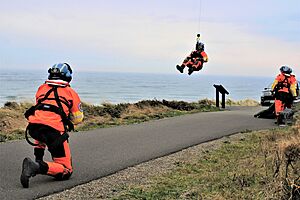
The U.S. Coast Guard Academy is a four-year college in New London, Connecticut. About 200 cadets graduate each year. They earn a science degree and become an ensign in the Coast Guard. Graduates must serve at least five years. Most work on Coast Guard cutters after graduation. Some go directly to flight training or shore duty.
Another way to become an officer is through Officer Candidate School (OCS). This 17-week course is also at the Academy. It trains college graduates to be effective officers. OCS teaches military life and technical skills.
OCS graduates usually become ensigns. Some with advanced degrees may start as lieutenants. Active duty OCS officers serve at least three years, while reserve officers serve four. They might be assigned to a ship, flight training, or a shore job. OCS is the main way enlisted members become officers. The Coast Guard does not have an ROTC program.
Lawyers, engineers, and pilots from other military branches can also become Coast Guard officers. This happens through the Direct Commission Officer (DCO) program. This course is three, four, or five weeks long. It's for people with special professional training or military experience.
Recruit Training (Boot Camp)
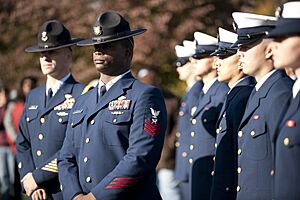
New enlisted members go to eight weeks of recruit training at Coast Guard Training Center Cape May in Cape May, New Jersey. Recruits spend three days getting processed. This includes haircuts, vaccinations, and getting uniforms. Temporary company commanders teach them how to march. After processing, permanent company commanders take over for the rest of the training.
The eight-week boot camp teaches teamwork and physical skills. Recruits learn about the Coast Guard's core values. These values are Honor, Respect, and Devotion to Duty.
The nine Recruit Training Objectives are:
- Self-discipline
- Military skills
- Marksmanship
- Vocational skills and academics
- Military bearing
- Physical fitness and wellness
- Water survival and swim qualifications
- Esprit de corps
- Core values (Honor, Respect, and Devotion to Duty)
Advanced Service Schools
After boot camp, most members go to their first unit. Then they wait for orders to attend advanced training at "A" Schools. At "A" schools, enlisted personnel learn their chosen job or "rating." A rating is a Coast Guard and Navy term for a specific skill. Members with high test scores might go directly to "A" School after boot camp.
Civilian Employees
The Coast Guard employs over 8,577 civilians. They work in more than 200 different jobs. These include Coast Guard Investigative Service special agents, lawyers, engineers, and administrative staff. Civilian employees support the Coast Guard's missions in many ways.
Coast Guard Equipment
Cutters: The Larger Ships
The Coast Guard has 243 Cutters. A cutter is any vessel longer than 65 feet (20 m). It has a permanent crew and living spaces for them.
- National Security Cutter (WMSL): These are the newest and largest cutters, at 418-foot (127 m) long. They replace older High Endurance Cutters. Eight are in service, and two are being built.
- Medium Endurance Cutter (WMEC): These are mostly 210-foot (64 m) Reliance-class and 270-foot (82 m) Famous-class cutters. Their main jobs are law enforcement, search and rescue, and defense. New Heritage-class cutters will replace them.
- Polar-class icebreaker (WAGB): There are three icebreakers for breaking ice and research. Two are active: the heavy 399-foot (122 m) Polar Star and the newer 420-foot (130 m) Healy. New, larger icebreakers are being built.
- USCGC Eagle: A 295-foot (90 m) sailing ship used for training Coast Guard Academy cadets. It was originally built in Germany and taken by the U.S. in 1945.
- USCGC Mackinaw: A 240-foot (73 m) heavy icebreaker for the Great Lakes.
- Seagoing Buoy Tender (WLB): These 225-foot (69 m) ships maintain navigation aids. They also help with law enforcement and search and rescue.
- Coastal Buoy Tender (WLM): The 175-foot (53 m) Keeper-class tenders maintain coastal navigation aids.
- Sentinel-class cutter (WPC): The 154-foot (47 m) Sentinel-class (Fast Response Cutter) is used for search and rescue and law enforcement.
- Bay-class icebreaking tug (WTGB): 140-foot (43 m) icebreakers used for breaking ice in harbors. They also do search and rescue, law enforcement, and navigation aid maintenance.
- Patrol Boats (WPB): The Coast Guard uses 110-foot (34 m) Island-class patrol boats and 87-foot (27 m) Marine Protector-class patrol boats.
- Small Harbor Tug (WYTL): 65-foot (20 m) small icebreaking tugboats. They clear ice in harbors and help with search and rescue and law enforcement.
Boats: The Smaller Vessels
The Coast Guard has about 1,650 boats. Boats are vessels less than 65 feet (20 m) long. They usually work near shore and on rivers.
Some Coast Guard boats include:
- Motor Lifeboat (MLB): The Coast Guard's 47-foot (14 m) main boat for bad weather. Used for search and rescue and law enforcement.
- Response Boat – Medium (RB-M): A new 45-foot (14 m) boat replacing older utility boats. 170 are planned.
- Deployable Pursuit Boat (DPB): A 38-foot (12 m) boat that can chase fast smuggling vessels.
- Long Range Interceptor (LRI): A 36-foot (11 m) fast boat launched from larger cutters.
- Aids to Navigation Boats (TANB/BUSL/ATON/ANB): Various sizes (26 to 55 feet (7.9 to 16.8 m)) used to maintain navigation aids.
- Special Purpose Craft – Law Enforcement (SPC-LE): A 33 feet (10 m) boat for law enforcement missions. It's very fast (over 50 knots (93 km/h; 58 mph)) and can go far from shore.
- Response Boat – Small (RB-S): A 25-foot (7.6 m) fast boat for search and rescue, port security, and law enforcement.
- Transportable Port Security Boat (TPSB): A 25-foot (7.6 m) armed boat used by Port Security Units for protection.
- Over-the-Horizon (OTH) boat: A 23-foot (7.0 m) inflatable boat used by cutters and special units.
- Short Range Prosecutor (SRP): A 23-foot (7.0 m) inflatable boat launched from National Security Cutters.
Aircraft: Flying High
The Coast Guard has about 201 airplanes and helicopters. They operate from 24 Coast Guard Air Stations across the U.S. and its territories. Most air stations are at civilian airports or former military bases.
Coast Guard pilots train with Navy and Marine Corps pilots. After training, they go to the U.S. Coast Guard Aviation Training Center in Mobile, Alabama. There, they get special training for the Coast Guard aircraft they will fly.
Airplanes fly long missions from air stations. Helicopters fly from air stations and can also deploy on cutters. Helicopters rescue people and stop smuggling boats. Since 2001, the Coast Guard uses armed helicopters in high-risk areas for law enforcement and anti-terrorism.
The Coast Guard is also developing unmanned aerial vehicles (UAVs) like the MQ-9 Reaper. These drones will help with homeland security and search/rescue. The Coast Guard works with the Navy and U.S. Customs and Border Protection to learn about these systems.
Current Aircraft in Use
| Type | Manufacturer | Origin | Class | Role | Introduced | In service | Notes |
|---|---|---|---|---|---|---|---|
| C-27J Spartan | Alenia Aeronautica | U.S. Italy |
Turboprop | Search and rescue | 2014 | 14 | These planes were given to the Coast Guard from the Air Force. |
| C-37A | Gulfstream | U.S. | Jet | Priority Airlift | 1998 | 1 | Used for important people in the Department of Homeland Security and Coast Guard. |
| C-37B | Gulfstream | U.S. | Jet | Priority Airlift | 2017 | 1 | Also used for important people in the Department of Homeland Security and Coast Guard. |
| HC-130H Hercules | Lockheed Martin | U.S. | Turboprop | Search and rescue | 1974 | 14 | Most are being replaced by newer HC-130J aircraft. |
| HC-130J Hercules | Lockheed Martin | U.S. | Turboprop | Search and rescue | 2003 | 12 | More are on order to replace the older HC-130H. |
| HC-144A Ocean Sentry | Airbus | U.S. Spain |
Turboprop | Search and rescue | 2009 | 15 | |
| HC-144B Minotaur | Airbus | U.S. Spain |
Turboprop | Search and rescue | 2016 | 3 | This is an upgraded version of the HC-144A with better navigation and search equipment. |
| MH-60T Jayhawk | Sikorsky | U.S. | Helicopter | Medium Range Recovery (MRR) | 1990 | 51 | These helicopters might stay in service until 2035. |
| MH-65D Dolphin | Eurocopter | U.S. France |
Helicopter | Short Range Recovery (SRR) | 1984 | 52 | |
| MH-65E Dolphin | Eurocopter | U.S. France |
Helicopter | Short Range Recovery (SRR) | 1984 | 46 | This is an upgraded version of the MH-65D with better systems. |
Weapons Used by the Coast Guard
Most Coast Guard Cutters have one or more naval gun systems:
- The Oto Melara 76 mm is a computer-controlled gun used on Medium Endurance Cutters. It can fire quickly and use special ammunition. This makes it useful against ships, aircraft, and for supporting ground forces.
- The MK 110 57mm gun is a computer-controlled version of the Bofors 57 mm gun. It's used on the National Security Cutters. It can be used against ships, aircraft, and missiles. It has a special design to reduce its radar signature.
- The Mk 38 Mod 0 weapon system has an M242 Bushmaster 25mm chain gun. It's operated by a person and helps defend ships against various targets like patrol boats and mines.
- The Mk 38 Mod 2 is a remote-controlled version of the Mk 38. It has an electronic sight, laser range-finder, and thermal camera for better accuracy.
- The Phalanx CIWS (pronounced "sea-wiz") is a close-in weapon system. It defends against aircraft and anti-ship missiles. It can also be used against surface targets. It has a radar-guided 20mm cannon and is used on National Security Cutters.
- The Sea PROTECTOR MK50 is a remote-controlled M2 .50 caliber heavy machine gun. It has cameras and a laser rangefinder. It's used on only four Marine Protector-class Cutters.
Small Arms and Light Weapons
The U.S. Coast Guard uses many types of small weapons. Handguns, shotguns, and rifles are used by boat crews and boarding teams. Machine guns are on cutters, boats, and helicopters.
Some small arms and light weapons include:
- M9 9mm pistol
- SIG Sauer P229R DAK .40 S&W pistol
- Remington M870P 12 gauge shotgun
- M16A2 rifle
- M4 carbine
- Mk 18 carbine
- M14 Tactical rifle
- Mk 11 (KAC SR-25)
- Mk 11 Mod 2 precision rifle
- FN M240 machine gun
- M2 .50 caliber heavy machine gun
- Mk 19 40mm grenade launcher
- Barrett M107 .50-caliber rifle, used by special teams to stop fleeing boats.
Symbols and Values of the Coast Guard
Core Values: Honor, Respect, Devotion to Duty
Like other U.S. armed services, the Coast Guard has core values. These are ethical rules for all Coast Guard members and civilians. The Coast Guard Core Values are:
Honor: We are honest and do the right thing. We are loyal and responsible to the public.
Respect: We value everyone in our team. We treat each other fairly and with kindness. We encourage everyone to grow and be creative. We work as a team.
Devotion to Duty: We are professionals who take responsibility and work hard to reach our goals. We are here to serve and we do it with pride.
The Coast Guard Ethos
In 2008, the Coast Guard created the Guardian Ethos. Admiral Allen, the Commandant, said it "defines the essence of the Coast Guard." It's like a promise the Coast Guard makes to the nation. In 2011, the name changed to Coast Guard Ethos to better reflect the term "Coast Guardsman."
The Ethos is:
In Service to our Nation
With Honor, Respect, and Devotion to Duty
We protect
We defend
We save
We are Semper Paratus
We are the United States Coast Guard—The Coast Guard Ethos
Creed of the United States Coast Guardsman
Vice Admiral Harry G. Hamlet wrote the "Creed of the United States Coast Guardsman." He was the Commandant from 1932 to 1936.
I am proud to be a United States Coast Guardsman.
I respect the many skilled sailors who, by their dedication and sacrifice, made it possible for me to be part of a service honored worldwide.
I will never, by my words or actions, bring shame to my service, nor let others do so without challenge.
I will happily obey all lawful orders.
I will always be on time to take over duties, and I will try to do more than my share.
I will always be at my post, alert and focused on my duties.
As much as I can, I will bring solutions, not problems, to my leaders.
I will live happily, but always respecting the rights of others.
I will try to be a good citizen in my community.
I will fight fiercely against an enemy of my country, but I will freely risk my life to rescue those in danger.
With God's help, I will try to be one of His noblest Works...
A UNITED STATES COAST GUARDSMAN.—Creed of the United States Coast Guardsman
"You have to go out, but you don't have to come back!"
This unofficial motto comes from an 1899 rule for the United States Life-Saving Service. It meant that rescuers had to keep trying to save people until it was truly impossible. They couldn't just say the sea was too rough without trying.
Coast Guard Ensign (Flag)
The Coast Guard Ensign (flag) was first used in 1799 by the Revenue Cutter Service. It helped tell revenue cutters apart from merchant ships. The flag had "sixteen perpendicular stripes (for the number of states at the time), alternating red and white." It also had the U.S. arms in dark blue on a white field.
This flag was a sign of authority for the Revenue Cutter Service. It was meant for their ships and boats. Later, it was also flown on custom houses. In 1910, President William Howard Taft added an emblem to the ensign. This made it different from the flag flown at custom houses. The emblem changed to the official Coast Guard seal in 1927.
The ensign helps ship captains recognize vessels with legal authority to stop and board them. It is only flown to show law enforcement power. It is not used in parades.
Coast Guard Standard
The Coast Guard Standard is a flag used in parades. It shows the Coast Guard's battle honors. It came from the jack of the Coast Guard ensign. This jack was flown by revenue cutters. The emblem is a blue eagle from the U.S. coat of arms on a white background. Above the eagle are the words "UNITED STATES COAST GUARD." Below it are the motto, "SEMPER PARATUS," and "1790."
Service Mark ("Racing Stripe")
The Racing Stripe is officially called the Service Mark. It was designed in 1964 by Raymond Loewy Associates. The goal was to give the Coast Guard a unique, modern look. President Kennedy was impressed with Loewy's work on Air Force One. He suggested Loewy help other government agencies, starting with the Coast Guard. The stripes are angled at 64 degrees, which was the year they were designed.
The racing stripe is on Coast Guard cutters, aircraft, and many boats. It was first used officially on April 6, 1967. It has a narrow blue stripe, a narrow white stripe, and a wide red bar. The Coast Guard shield is in the middle. Red-hulled icebreakers and most red helicopters have a narrow blue stripe, a narrow red stripe (the hull color), and a wide white bar. Black-hulled cutters use the standard racing stripe. Volunteer Auxiliary vessels also have the Racing Stripe, but with inverted colors (wide blue stripe with narrow white and red stripes) and the Auxiliary shield. Other coast guards and law enforcement agencies have adopted similar designs.
Uniforms of the Coast Guard
For most of its history, Coast Guard uniforms looked like U.S. Navy uniforms. Only the insignia was different. In 1974, Admiral Chester R. Bender introduced new Coast Guard uniforms. These were different from traditional naval uniforms. "Bender's Blues" became a common uniform for all ranks. It replaced the sailor suit worn by enlisted members. Rank insignia stayed the same as the Navy's. Some traditional items like the pea coat and dress white uniforms remained.
Today, Coast Guard uniforms are simpler than other military branches. They have fewer types of uniforms. There are only three main uniforms for daily wear: the Operational Dress Uniform, Tropical Blue, and Service Dress Blue (Bravo).
Coast Guard Reserve: Ready to Serve
The United States Coast Guard Reserve is the Coast Guard's reserve military force. It was started on February 19, 1941. The Coast Guard has 8,700 reservists. They usually train two days a month and do 12 extra days of active duty each year. Many do more training and active duty. Coast Guard reservists have the same training as active duty members. They often work alongside active duty units every day.
After September 11, 2001, reservists were called to active duty. They served in places like the Persian Gulf. Coast Guard Port Security Units are almost entirely made up of reservists.
Women in the Coast Guard
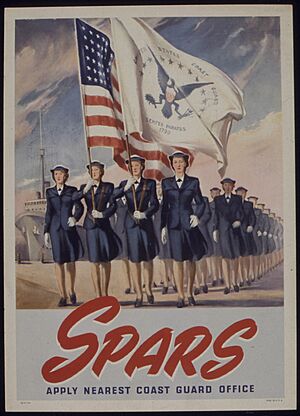
Women have served in the United States Coast Guard since 1918. They continue to serve today.
In January 1918, Myrtle Hazard joined the Coast Guard. She became a radio operator and then an electrician. She was the only woman to serve during World War I. A Coast Guard ship, the USCGC Myrtle Hazard, is named after her.
Coast Guard Auxiliary: Volunteers Helping Out
The United States Coast Guard Auxiliary is a group of uniformed, non-military volunteers. Congress created it on June 23, 1939. It was first called the "United States Coast Guard Reserve." It was renamed the "United States Coast Guard Auxiliary" in 1941 when a military reserve force was created. As part of "Team Coast Guard," the Auxiliary helps with almost all of the Coast Guard's non-military and non-law enforcement missions. Auxiliarists follow directions from the Commandant of the Coast Guard. In 2022, there were about 26,000 members.
The Coast Guard has given many duties related to boating safety to the Auxiliary. This includes teaching boating skills and offering free Vessel Safety Checks to the public. Auxiliarists also use their own boats and aircraft to help the Coast Guard. They do safety patrols, help with search and rescue, and check navigation aids.
Before 1997, Auxiliarists mainly focused on recreational boating safety. But in 1997, a new law allowed them to help with almost all Coast Guard missions. They cannot directly participate in military or law enforcement actions. However, they can help active duty personnel with tasks like radio communications or inspecting commercial vessels. Auxiliarists cannot carry weapons while serving.
Awards and Honors for Coast Guard Members
One Coast Guardsman, Douglas Albert Munro, received the Medal of Honor. This is the highest military award in the United States. Fifty-five Coast Guardsmen have earned the Navy Cross. Many others have earned the Distinguished Flying Cross.
The highest award given during peacetime in the Coast Guard is the Homeland Security Distinguished Service Medal. Before the Coast Guard moved to the Department of Homeland Security, it was the Department of Transportation Distinguished Service Medal. The highest award for a group is the Presidential Unit Citation.
In wartime, Coast Guard members can receive the Navy version of the Medal of Honor. A specific Coast Guard Medal of Honor is allowed but has not been created yet.
In May 2006, President George W. Bush gave the entire Coast Guard, including the Auxiliary, the Coast Guard Presidential Unit Citation. This was for their efforts during and after Hurricane Katrina and Tropical Storm Rita.
Famous People in the Coast Guard
Many famous people have served in the Coast Guard. These include tennis player Jack Kramer and golfer Arnold Palmer. Boxer Jack Dempsey and author Alex Haley also served. Musicians like Tom Waits and actors like Beau Bridges and Jeff Bridges were Coast Guardsmen.
Vice Admiral Thad Allen led the recovery efforts after Hurricane Katrina in 2005. Later, as an Admiral and Commandant, he oversaw the response to the Deepwater Horizon oil spill.
Some former Coast Guard officers have held important government jobs. After retiring, Admiral James Loy became the United States Deputy Secretary of Homeland Security. Carlton Skinner became the first Civilian Governor of Guam. G. William Miller became the 65th Secretary of the Treasury.
Two Coast Guard pilots, Commander Bruce E. Melnick and Captain Daniel C. Burbank, became NASA astronauts.
Signalman First Class Douglas Albert Munro received the Medal of Honor after he died. He is the only Coast Guardsman to receive this honor.
Coast Guard Organizations
Coast Guard Aviation Association
Pilots and crew who have flown in Coast Guard aircraft can join the Coast Guard Aviation Association. The "Ancient Albatross Award" is given to the active duty Coast Guard aviator who earned their wings earliest.
Coast Guard CW Operators Association
The Coast Guard CW Operators Association (CGCWOA) is for former Coast Guard members. These members were Radiomen or Telecommunications Specialists who used Morse Code in their duties.
USCG Chief Petty Officers Association
This group helps members and their families. They also support Coast Guard recruiting and the Chief Petty Officers Academy. Members include active, reserve, and retired Chief, Senior Chief, and Master Chief Petty Officers. Chief Warrant Officers and Officers who were Chief Petty Officers can also join.
USCG Chief Warrant and Warrant Officers Association (CWOA)
Founded in 1929, the Chief Warrant and Warrant Officers Association (CWOA) represents Coast Guard warrant and chief warrant officers. They communicate with Congress, the White House, and the Department of Homeland Security. They also talk with Coast Guard leaders about issues important to chief warrant officers.
Images for kids
-
Marine Corps Privates First Class William A. McCoy and Ralph L. Plunkett holding a sign thanking the Coast Guard after the Battle of Guam in 1944
-
A gun crew on board USCGC Point Comfort (WPB-82317) firing an 81mm mortar during the bombardment of a suspected Viet Cong staging area one mile behind An Thoi in August 1965
-
United States Coast Guard Squadron One unit patch during the Vietnam War
-
USS Vandegrift (FFG 48) and USCGC Mellon (WHEC-717) cruising side by side in the Java Sea on May 28, 2010
-
A member of USCG Law Enforcement Detachment (LEDET) 106 performing a security sweep aboard a tanker ship in the North Persian Gulf in July 2007
-
A Coast Guard Aviation Survival Technician assisting with the rescue of a pregnant woman during Hurricane Katrina in 2005
See also
 In Spanish: Guardia Costera de Estados Unidos para niños
In Spanish: Guardia Costera de Estados Unidos para niños
U.S. Coast Guard
- AMVER
- Badges of the United States Coast Guard
- Chaplain of the United States Coast Guard
- Coast Guard Day
- Coast Guard Intelligence
- Code of Federal Regulations, Title 33
- Joint Maritime Training Center
- List of United States Coast Guard cutters
- List of United States Coast Guard stations
- Maritime Law Enforcement Academy
- Maritime Security Risk Analysis Model
- MARSEC
- National Data Buoy Center
- Naval militias in the United States
- North Pacific Coast Guard Agencies Forum
- Patrol Forces Southwest Asia
- SPARS
- United States Coast Guard Legal Division
- United States Coast Guard Police
- United States Coast Guard Research & Development Center
- U.S. National Ice Center
Related agencies
- List of United States federal law enforcement agencies
- National Oceanic and Atmospheric Administration Fisheries Office of Law Enforcement
- U.S. Immigration and Customs Enforcement (ICE)
- United States Maritime Service
- United States Merchant Marine


